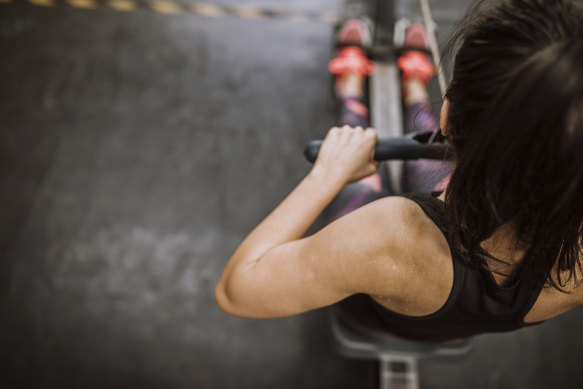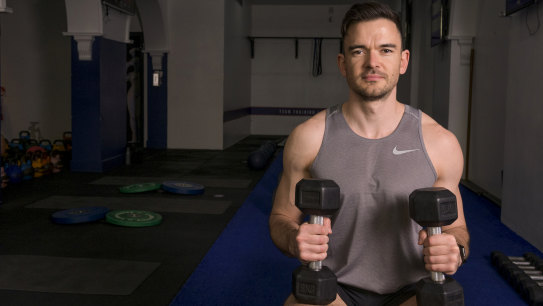As you embark on your fitness journey, remember that every step, every workout, and every milestone brings you closer to becoming the best version of yourself. Embrace the process, celebrate your progress, and revel in the remarkable changes that unfold, one day, one month, and one year at a time
How exercise changes your body after a day, a week, a month, a year
With COVID-19 lockdowns hopefully behind us, gyms back in business and increasing sunshine coaxing us back outside, you might find yourself returning your focus to your fitness.
But of course, getting back into an exercise regime is rarely pleasant.

“Starting back is always difficult,” says Associate Professor Rob Robergs, an accredited exercise physiologist from Queensland University of Technology, explaining that we begin to lose our physical fitness rapidly when we stop training – in as little as one week – even if we’d been very active before.
“These losses can occur up to 10 times faster than the gains do,” Robergs says.
But don’t let that dissuade you. Robergs stresses the importance of reintroducing intense exercise into your routine because it offers enormous physical and mental health benefits.
From the moment you start exercising again, your body begins complex processes to rebuild its fitness and, while change is slow, it’s continuous and worth lacing up for the long haul for.
On the day of exercise
Exhausted, breathless and feeling clumsy? That’s OK. The first workout is unlikely to leave you feeling as accomplished as you might have hoped, Robergs says.
“You’ll have the perception that, generally speaking, things were much harder to do,” he says. “There’s a lot of physiology that goes into that movement.”
First, Robergs explains, your brain is doing a lot of work to co-ordinate all these new nerve patterns to your muscles. “There’s a lot of mental effort that’s very subconscious,” he says, adding it’s why you have to concentrate when exercising.
“It’s amazing how rapidly the muscles adapt … They become stronger and more tolerant.”
Associate Professor Rob Robergs, accredited exercise physiologist, QUT
When you take a break from working out, your body shrinks muscle fibres and breaks down blood vessels in the muscles that are no longer being used. “The body is always trying to conserve as much energy as possible,” Robergs says.
It means when you return to exercise, you’re fatigued because high demand is being heaped onto your heart and lungs to increase blood flow through your contracting muscles, but your body has become less effective at doing this.
The upside? As your body pushes to oxygenate the muscles, this stimulates surrounding tissue to again start synthesising those blood vessels and muscle fibres you’d lost.
Accredited exercise physiologist Sam Rooney, from Sydney’s Ion Training, says you’ll be spent even if you’d been exercising in lockdown but are introducing a new routine. “It will help but it’s not the same. You’re still challenging your body in a completely different way.”
Advice for meeting Australia’s physical activity guidelines
- Adults should do at least 150-300 minutes of moderate intensity exercise each week, or 75-150 minutes of vigorous activity. Gradually build to this.
- Do resistance or weight training at least two days a week.
- Aim to be active on most (preferably all) days every week, even if only for a few minutes.
- Robergs advises taking it easy at first to avoid injury as your muscles, tendons, ligaments and joints will have deteriorated more than you think.
- Remember to warm up before each session and finish with some stretching.
- Consider starting with body weight supported exercises, so cycling and swimming instead of running, or using seated weight machines instead of free weights.
- Pre-empt the moment, perhaps a few months in, when you’ll lose motivation or become impatient. To prevent yourself from giving up, Robergs recommends having a strategy you can put in place: it could be planning to train with friends or to switch to a new gym.
In the day after
The main thing you’ll notice is aching muscles when you wake up the next day. Where the pain is will depend on your workout, but it’s possible that stairs won’t be your friend for three or four days. That’s because lengthening and contracting your muscles can cause microscopic damage, resulting in delayed onset muscle soreness, also known as “DOMS”.
But it serves a purpose, Robergs says: “It’s an unfortunate part of the muscle’s response but it does improve the muscle structure and function.”
It only becomes a concern with severe pain, as it means you’ve done too much too quickly. “Barely being able to sit down [the next day] means you’ve overdone it,” Rooney says.
But usually, it’s nothing to be alarmed about, Robergs says, and the next time you work out, you’re “incredibly unlikely” to be as sore again.
“It’s amazing how rapidly the muscles adapt,” he says. “They become stronger and more tolerant.”
Rooney says he generally recommends exercising through muscle soreness. “Ironically the best way to get rid of that soreness is with movement … as long as your movement is not compromised.”
Your resting metabolic rate also increases after training. Your body consumes more energy for muscle repair, therefore burning more calories when not exercising. “One study showed that, after 45 minutes of vigorous cycling, participants experienced an approximately 40 per cent rise in their metabolic rate for 14 hours,” Rooney says.
Robergs says another immediate effect you can expect after exercising is reduced appetite. “Most people think that if you exercise and expend calories, you’ll get really hungry, but if you’re hungry before working out, you’ll find that goes,” he says. “[Put simply] the hormonal response to exercise and the energies you expend reset the brain and sense of hunger.”
You may also find your sleep improves. “Your body wants to repair overnight, that’s when all the adaptation occurs, all the repair to the muscles and improvements to fluid distribution and all the important added protein synthesis to build more muscle fibres,” says Robergs, adding that poor sleep can compromise your ability to adapt to your training.
After a week
At the end of the first week, Robergs says you should ideally be not too sore, not injured, but feeling as though you’re more energetic and needing to do more. “It’s not about how far you can run or swim or how high you can jump, it’s about how you’re feeling.”
The brain’s release of feel-good hormones – such as endorphins – while training is believed to be partly responsible for this shift in mindset, Robergs says. Exercise is well-known for its mood-boosting powers. It’s why some people eventually develop a deep-seated need to exercise regularly. “We know that, once you’ve started back into training and you’ve overcome those first stress perceptions, there’s a craving for it.”
Rooney adds: “On a cellular level, mitochondria – mini power plants that produce energy – multiply, meaning that your body can produce more energy.”
This stage is too soon to see any physical changes. “You might feel as though you look a bit more muscular because there’s more blood flow, but it won’t have been muscle growth as such,” Rooney says. “After a week it’s more about the mental side … You’re starting to feel those mental health benefits.”

2:08
Paul Dardagan’s three-minute hourly exercise
Paul Dardagan demonstrates five simple movements that can make a difference to your physical and mental wellbeing.
After a month
After a month of regular exercise, you will be noticing improvements to your strength and fitness. “You may be able to do more reps in weight training or slightly raise the load, or you’re able to walk, jog or cycle a bit faster,” Robergs says. “One month still isn’t a lot of time but you’ll notice you’re better able to tolerate your workout and recovery doesn’t take as long.”
Rooney says initial strength gains are largely thanks to the nervous system learning how to more efficiently contract your muscles – be it working a few muscles at once, or improving the rate at which you’re firing up your muscles. “As that messaging gets better, more fibres are working.”
The difference in someone’s mood and confidence is quite profound.
Sam Rooney, accredited exercise physiologist, Ion Training
But with each session, your body works hard to develop larger muscle fibres and, as your muscles slowly gain in volume, they’re better able to store and use fuel in the form of carbohydrates and fats (thanks again to those mitochondria), Robergs says.
There’s also better supply of blood to your muscles. Your cardiovascular system is working better because increased hydration leads to larger blood volume. And the heart strengthens, efficiently pumping more blood around the body with each beat, allowing it to beat more slowly when resting.
You might notice you’re sweating more when training. That’s because your body has become better at regulating its temperature, Robergs says. “Your body is more sensitive to the need to remove heat, and as you get more physically fit, you are working harder and therefore producing more heat.”
A month in, you may notice some minor changes to your appearance but this is a slow process, and visible change mainly comes about the three-month mark. “The muscles become a bit more defined and more hypertrophied, but you might feel that more than see that. [And] body fat reduction is long-term, usually beyond three months,” Robergs says.
Most importantly, at this point you should mentally be feeling really great, which is a motivator in itself. Consider this your “aha” moment. “If you can get to four good weeks of exercise, I think that’s something to celebrate. You’ve set yourself up to continue to succeed,” Rooney says.
After a year
Those improvements you saw to your strength and fitness after the first month will now be significantly larger. That means, Robergs says, your endurance and ability to keep your muscles contracting will be better, as will the amount of load you can lift and the speed with which you do that action. You should also feel more flexible, agile and have less back and joint pain.
Whether or not it’s one of your goals, you’ll probably see changes to your physical appearance, be it your body weight or muscle mass.
You’ll also find your realm of potential recreational pursuits has broadened, Robergs says. Playing with little children might be less physically taxing, or you may now be able to do more challenging bush walks, register for fun runs and swims, or plan to hike in the Himalayas or walk the Camino in Spain.
The body’s physical changes – a stronger heart, bones and muscles – play a key role in reducing your risk of developing serious health conditions, including heart disease, type two diabetes, cancer and obesity.
Regular exercise also enormously benefits our mental wellbeing. Research has consistently found that people who work out regularly experience fewer symptoms of depression and anxiety. Training can be as effective as antidepressant medication as they both increase the size of the brain’s hippocampus.
And just generally, you will likely be feeling happier than you did a year ago. Research shows people who work out even once a week tend to be more cheerful than those who never exercise. “The difference in someone’s mood and confidence is quite profound,” Rooney says.
The bottom line? When you’ve been exercising for this long, you will see all that initial pain was worth it.
Discover more from ReviewFitHealth.com
Subscribe to get the latest posts sent to your email.

